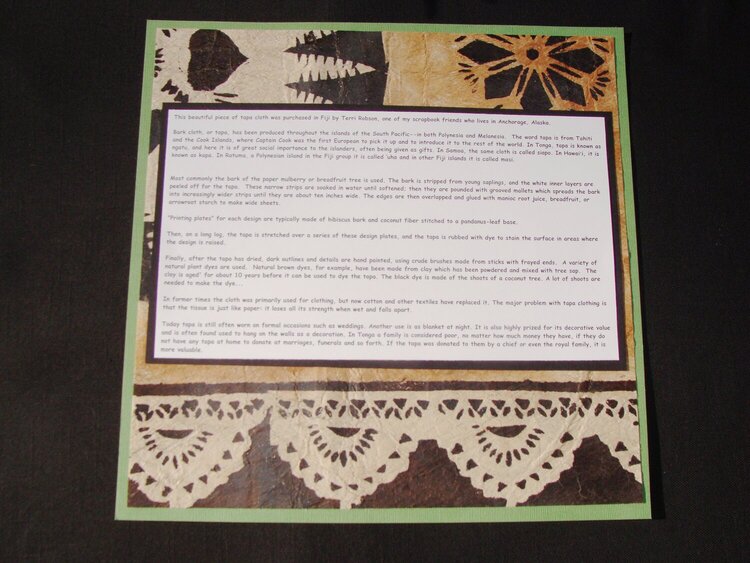EXTRA 11% OFF Orders $100+ With Code: THANKYOU


 Give a Cheer
Give a Cheer
This beautiful piece of tapa cloth was purchased in Fiji by Terri Robson, one of my scrapbook friends who lives in Anchorage, Alaska.
Bark cloth, or tapa, has been produced throughout the islands of the South Pacific--in both Polynesia and Melanesia. The word tapa is from Tahiti and the Cook Islands, where Captain Cook was the first European to pick it up and to introduce it to the rest of the world. In Tonga, tapa is known as ngatu, and here it is of great social importance to the islanders, often being given as gifts. In Samoa, the same cloth is called siapo. In Hawaiʻi, it is known as kapa. In Rotuma, a Polynesian island in the Fiji group it is called ‘uha and in other Fiji islands it is called masi.
Most commonly the bark of the paper mulberry or breadfruit tree is used. The bark is stripped from young saplings, and the white inner layers are peeled off for the tapa. These narrow strips are soaked in water until softened; then they are pounded with grooved mallets which spreads the bark into increasingly wider strips until they are about ten inches wide. The edges are then overlapped and glued with manioc root juice, breadfruit, or arrowroot starch to make wide sheets.
"Printing plates" for each design are typically made of hibiscus bark and coconut fiber stitched to a pandanus-leaf base.
Then, on a long log, the tapa is stretched over a series of these design plates, and the tapa is rubbed with dye to stain the surface in areas where the design is raised.
Finally, after the tapa has dried, dark outlines and details are hand painted, using crude brushes made from sticks with frayed ends. A variety of natural plant dyes are used. Natural brown dyes, for example, have been made from clay which has been powdered and mixed with tree sap. The clay is aged' for about 10 years before it can be used to dye the tapa. The black dye is made of the shoots of a coconut tree. A lot of shoots are needed to make the dye.
In former times the cloth was primarily used for clothing, but now cotton and other textiles have replaced it. The major problem with tapa clothing is that the tissue is just like paper: it loses all its strength when wet and falls apart.
Today tapa is still often worn on formal occasions such as weddings. Another use is as blanket at night. It is also highly prized for its decorative value and is often found used to hang on the walls as a decoration. In Tonga a family is considered poor, no matter how much money they have, if they do not have any tapa at home to donate at marriages, funerals and so forth. If the tapa was donated to them by a chief or even the royal family, it is more valuable.
No products have been added to this project.
Thanks for spreading positivity!
February 24, 2011
January 26, 2011
January 26, 2011
January 25, 2011
January 24, 2011